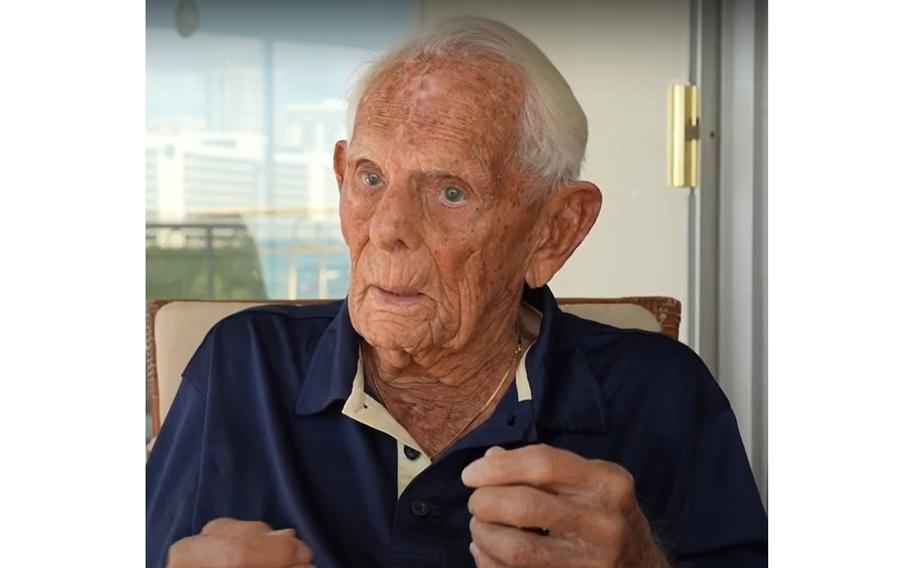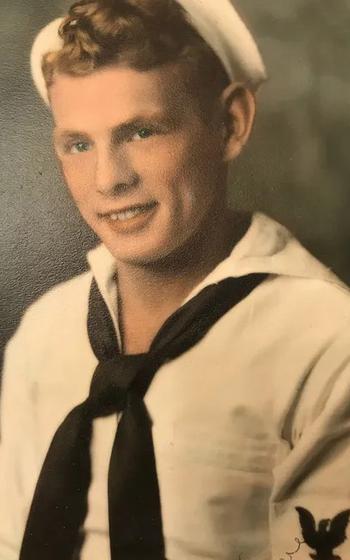
Harry Chandler talks about his experiences during the Dec. 7, 1941, attack on Pearl Harbor in this screenshot from a video interview conducted in Hawaii on Dec. 8, 2023. (Pacific Historic Parks)
Harry Chandler, a Navy corpsman who witnessed the Pearl Harbor attack in 1941 from a hillside hospital before rushing to take part in a watery rescue mission, died Monday in Palm Beach County, Fla. He was 103.
Chandler’s death leaves only 14 veterans of the attack known to be alive, according to a tally maintained by Kathleen Farley, president of the California chapter of Sons and Daughters of Pearl Harbor Survivors.
His death comes less than a week after that of Warren “Red” Upton, who died on Christmas in California at age 105.
“It is with profound sadness that we announce Harry Chandler, after a swift downturn over the past several days, passed peacefully at 5:08 pm ET,” Chandler’s family said in a statement published Monday by WPTV-5 in West Palm Beach. “We are gutted by this loss of our Pappy but comforted by the fact few have lived on Earth as fully and long as he did and now he is with many who passed before him.”
From the time Chandler was a child, raised in Massachusetts in part during the hardscrabble years of the Great Depression, he wanted to be a sailor.

Harry Chandler, who died Dec. 30, 2024, poses for an undated photo taken during World War II. (Pacific Historic Parks)
For years, he begged his parents for a sailor suit, and they eventually gave in.
“It was a bit too small, but it felt so good, so good,” Chandler said during a video interview in Hawaii with Pacific Historic Parks on Dec. 8, 2023, a day after he attended the 82nd commemoration of the Japanese surprise attack at the Pearl Harbor National Memorial.
“I don’t know why, but I was always sort of interested in the Navy,” he said. “There was just something about the Navy. I didn’t know too much about it, but I wanted to be a sailor in the Navy.”
Chandler skipped graduating from high school and instead joined the Navy during his senior year.
On Dec. 7, 1941, he learned more than any book could teach.
“I grew up very quickly, very quickly, that one day,” Chandler said. “I thought I was a big shot being in the Navy, but I wasn’t a man. I was still a kid. That day turned me into a man.”
Chandler arrived in Hawaii in September 1941 and was assigned to Mobile Hospital No. 2, a complex of metal huts perched on the hillside of Aiea Heights overlooking Pearl Harbor.
On the morning of Dec. 7, he was preparing to raise the hospital’s flag when he heard the roar of airplanes, he recalled in the interview.
He assumed they were American planes arriving from the mainland.
“I saw them swooping,” he said. “I thought they must be practicing. Then I saw the bombs dropping.”
Within minutes, Chandler said he saw the fiery explosion of the USS Arizona as it was hit by bomber torpedoes.
“It was scary, but they put us in trucks to take us down to the harbor to do what we could do to help those poor guys,” he said.
They pulled the wounded from the water and transferred them to hospital beds.
The sight of so many corpses and so many men in agony profoundly affected the young hospital corpsman, and thoughts of it 82 years later brought Chandler to tears numerous times during the interview.
“The funny part of it was, you got so busy you weren’t scared at all. It was after that it got scary: Holy smokes — only it wasn’t ‘holy smokes’ we said — I could have been killed.”